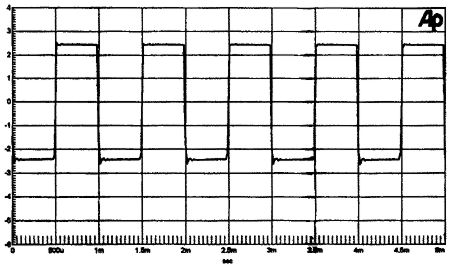| Columns Retired Columns & Blogs |
Conrad-Johnson CAV50 integrated amplifier Measurements
Sidebar 1: Measurements
On the test bench, the Conrad-Johnson CAV50 delivered a just-to-spec 53Wpc into 8 ohms (17.2dBW) for 1% distortion, midband. Loaded down to 4 ohms, it measured 78Wpc (15.9dBW) single-channel, showing a respectable load tolerance for a tube amplifier. The output rating fell 1dB with both channels driven (eg, to 16dBW, 40Wpc, at 1kHz). At low frequencies (20Hz) the amplifier clipped at 36W (15.6dBW) (which isn't bad), and raised 65W at this frequency into 4 ohms (15.1dBW). At the other end of the audio band, the amp delivered a true 56Wpc at 20kHz into 4 ohms at 1% THD, with 45W available into 8 ohms (16.5dBW). This is a good result, confirming low shunt losses in the output transformer.
The CAV50's output impedance was moderate, constant at virtually 0.4 ohms over the audio bandwidth, and sufficiently low to keep frequency-response shifts due to typical load-impedance variations at the threshold of perception. Certainly I wasn't aware of any disturbing load interactions during the listening tests (though I didn't try the amplifier with the Quad ESLs).
Channel separation measured a very satisfactory maximum of 82.5dB at low and mid-frequencies, decreasing to a modest but wholly useable 58.1dB by 20kHz. Channel balance held to 0.013dB at full level, and was typically ±0.15dB over the main volume range, tipping to 0.9dB of imbalance at the lowest settings.
The input impedance was satisfactorily high, generally in the range of 45k ohms, providing gentle loading on signal sources. The CAV50 proved just sensitive enough for direct connection of nominal 2V CD players and similar signal sources. An input of 103mV gave 1W, while 700mV was needed for full output on 8 ohms loading. Some low-output sources, such as old tuners and tape decks, may not have enough output; check out this aspect.
The 1kHz squarewave into a resistive load (fig.1) shows a short risetime with a slight trace of ringing on the negative half-cycle. I found no sign of impaired stability on listening at the test bench, but reactive loading resulted in heavy and prolonged ringing (fig.2), indicating that the amplifier's stability wasn't unconditional, and that strongly capacitive loads such as electrostatic speakers are not recommended for this design. Previous C-Js haven't shown this tendency.

Fig.1 Conrad-Johnson CAV50, small-signal 1kHz squarewave into 8 ohms.

Fig.2 Conrad-Johnson CAV50, small-signal 1kHz squarewave into 8 ohms+2µF.
Into a resistive load, the CAV50 gave a perfectly flat frequency response of 5Hz-20kHz (fig.3). After a minor ripple at 23kHz, it continued out to -1dB at 50kHz before falling away to -3dB at 60kHz and -12dB at 125kHz. With 2µF reactive loading (not shown) there was a substantial response peaking at ultrasonic frequencies; this extended down into the upper audible range.

Fig.3 Conrad-Johnson CAV50, frequency response at 1W into 8 ohms. (1dB/vertical div.)
The CAV50 could deliver 50Wpc in the midband at a 0.5% distortion limit, while a reduction to the specified 45W improved the distortion to 0.3% or -50dB. Distortion rose to 1% at the lower and upper band limits. At more normal power levels, the distortion fell to substantially low levels, typically -60dB (0.1%) at 20Hz, -70dB (0.033%) at 1kHz, with -55dB (0.15%) measured at 20kHz.
While I think it's of little relevance to the listening experience, as first tested this sample had a distortion imbalance at lower powers in which one channel gave an astonishing -86dB at 1kHz, while the other measured a perfectly satisfactory -65dB of distortion. A minor tweak of the output bias settings served to exchanged distortion values between the two channels. The reason for this is that any bias offset will deliver some DC current through the transformer primary, resulting in some mild magnetizing distortion for this push-pull circuit. Careful setting of the relative tube bias will allow fine-tuning of the overall linearity. I didn't test the 2 ohm output, but did check for peak current. I saw +6.5A on the level meter: sufficient for the tested power rating, and more generous than several other tubed amplifiers.
The amplifier measured well for high-frequency intermodulation, with an expected -46dB or 0.5% at full-power clip, improving to a relatively clean -64dB by 1W. The spectrum for the 19+20kHz mixed-tone result (fig.4) shows a neatly controlled result. Checking up on the harmonic spectrum at moderate powers, 200Hz at 1W gave the nice result seen in fig.5. Aside from a trace of 100Hz (due to measurement grounding-line hum), the spectrum shows predominantly second harmonic at -74dB, a bit of third at -81dB, and just a sniff of fifth at -90dB—very satisfactory for tonal purity!

Fig.4 Conrad-Johnson CAV50, HF intermodulation spectrum, DC-20kHz, 19+20kHz at 1W into 8 ohms (linear frequency scale).

Fig.5 Conrad-Johnson CAV50, spectrum of 200Hz sinewave, DC-1kHz, at 1W into 8 ohms (linear frequency scale).
The unweighted S/N Ratio wasn't too special, referred to a 0dBW reference level, it was 63dB with some hum content. A-weighted (which also filters the hum component), the result was fine at 90dB, improving to 101dB relative to full output. Unweighted, the 50W reference level gave a S/N of 92dB, improving to 100dB excluding hum. In practice, the latter proved inaudible with the Wilson WITTs, but was just perceptible using the very sensitive Avantgarde Duos.—Martin Colloms
- Log in or register to post comments




































